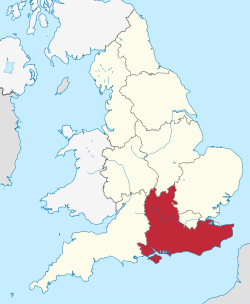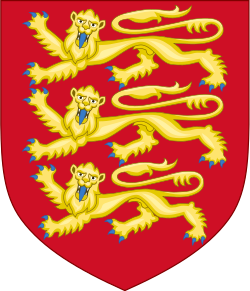
Back Sud-este d'Anglaterra AN جنوب شرق إنجلترا Arabic Sureste d'Inglaterra AST Югоизточна Англия Bulgarian দক্ষিণ পূর্ব ইংল্যান্ড Bengali/Bangla Gevred Bro-Saoz Breton Sud-est d'Anglaterra Catalan Jihovýchodní Anglie Czech De-ddwyrain Lloegr Welsh South East England Danish
This article needs additional citations for verification. (December 2016) |
South East | |
|---|---|
From top, left to right: Brighton; Oxford; Southampton; Canterbury; Windsor Castle; Blenheim Palace; White Cliffs of Dover | |
 South East region shown within England | |
| Coordinates: 51°18′N 0°48′W / 51.3°N 0.8°W | |
| Sovereign state | United Kingdom |
| Country | England |
| GO established | 1994 |
| RDA established | 1998 |
| GO abolished | 2011 |
| RDA abolished | 31 March 2012 |
| Subdivisions | 9 counties 64 districts
|
| Government | |
| • Type | Local authority leaders' board |
| • Body | South East Councils |
| • MPs | 84 MPs (of 650) |
| Area | |
• Total | 7,500 sq mi (19,400 km2) |
| • Land | 7,364 sq mi (19,072 km2) |
| • Rank | 3rd |
| Population (2022)[3] | |
• Total | 9,379,833 |
| • Rank | 1st |
| • Density | 1,270/sq mi (492/km2) |
| Ethnicity (2021) | |
| • Ethnic groups | |
| Religion (2021) | |
| • Religion | List
|
| Time zone | UTC+0 (GMT) |
| • Summer (DST) | UTC+1 (BST) |
| ITL code | TLJ |
| GSS code | E12000008 |
| This article is part of a series within the Politics of the United Kingdom on the |
 |
|---|
South East England is one of the nine official regions of England that are in the top level category for statistical purposes. It consists of the nine counties of Berkshire, Buckinghamshire, East Sussex, Hampshire, the Isle of Wight, Kent, Oxfordshire, Surrey and West Sussex. South East England is the third-largest region of England, with a land area of 19,072 square kilometres (7,364 sq mi), and is also the most populous with a total population of 9,379,833 in 2022.[3]
South East England contains nine legally chartered cities: Brighton and Hove, Canterbury, Chichester, Milton Keynes, Oxford, Portsmouth, Southampton, Southend-on-Sea and Winchester. Officially it does not include London, which is a separate region. The geographical term for "South East England" may differ from the official definition of the region, for example London, Bedfordshire, Hertfordshire and Essex are sometimes referred to as being in the south east of England.[5][6] This article only considers the South East as being the official statistical region.
In medieval times, South East England included much of the Kingdom of Wessex, which was the precursor to the modern state of England. Winchester was the capital of England after unification of the various states, including the kingdoms of Kent, Sussex and Mercia. Winchester stopped being the administrative capital of England some time in the 13th century as its influence waned while the City of London dominated commerce. The last monarch to be crowned at Winchester was Richard II in 1377, although the last monarch to be crowned by the Bishop of Winchester was Queen Mary I in 1553.
Today, the region's close proximity to London has led to South East England becoming a prosperous economic hub with the largest economy of any region in the UK, after London. The region is home to Gatwick Airport and Heathrow Airport (the UK's two busiest airports). The coastline along the English Channel provides numerous ferry crossings to mainland Europe. South East England is also known for its countryside, which includes two national parks: the New Forest and the South Downs, as well as the North Downs, the Chiltern Hills and part of the Cotswolds. The River Thames flows through the region and its basin is known as the Thames Valley.
It is also the location of a number of internationally known places of interest, such as HMS Victory in Portsmouth, Cliveden in Buckinghamshire, Thorpe Park and RHS Wisley in Surrey, Blenheim Palace in Oxfordshire, Windsor Castle in Berkshire, Leeds Castle, the White Cliffs of Dover and Canterbury Cathedral in Kent, Brighton Palace Pier, and Hammerwood Park in East Sussex, and Wakehurst Place in West Sussex. The region has many universities; the University of Oxford is the oldest in the English-speaking world, and ranked among the best in the world.
South East England is host to various sporting events, including the annual Henley Royal Regatta, Royal Ascot and The Derby, and sporting venues include Wentworth Golf Club and Brands Hatch. Some of the events of the 2012 Summer Olympics were held in the south east, including the rowing at Eton Dorney and part of the cycling road race in the Surrey Hills.
- ^ "South East Councils (SEC) - Councils in Partnership". South East Councils. Retrieved 10 August 2024.
- ^ "Standard Area Measurements (Latest) for Administrative Areas in the United Kingdom". Open Geography Portal. Office for National Statistics. 24 April 2024. Retrieved 6 May 2024.
- ^ a b "Mid-Year Population Estimates, UK, June 2022". Office for National Statistics. 26 March 2024. Retrieved 3 May 2024.
- ^ a b UK Census (2021). "2021 Census Area Profile – South East Region (E12000008)". Nomis. Office for National Statistics. Retrieved 14 August 2023.
- ^ "What regions make up the North and South of England? | YouGov". yougov.co.uk. Retrieved 1 February 2025.
- ^ Chapman, Keir (26 February 2024). "Essex, England". Earth Site Education. Retrieved 1 February 2025.
© MMXXIII Rich X Search. We shall prevail. All rights reserved. Rich X Search






